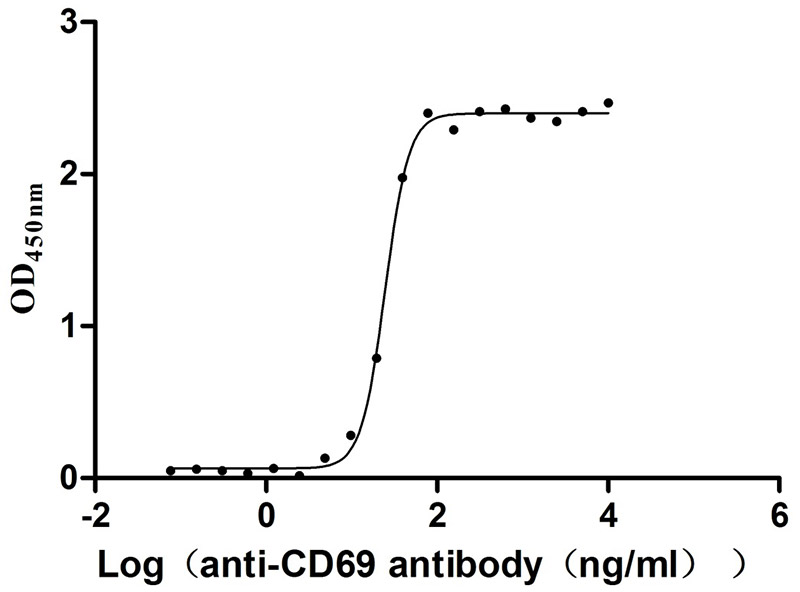Recombinant Mouse Deoxynucleoside triphosphate triphosphohydrolase SAMHD1 (Samhd1)
-
中文名称:小鼠Samhd1重组蛋白
-
货号:CSB-EP020691MO
-
规格:
-
来源:E.coli
-
其他:
-
中文名称:小鼠Samhd1重组蛋白
-
货号:CSB-EP020691MO-B
-
规格:
-
来源:E.coli
-
共轭:Avi-tag Biotinylated
E. coli biotin ligase (BirA) is highly specific in covalently attaching biotin to the 15 amino acid AviTag peptide. This recombinant protein was biotinylated in vivo by AviTag-BirA technology, which method is BriA catalyzes amide linkage between the biotin and the specific lysine of the AviTag.
-
其他:
-
中文名称:小鼠Samhd1重组蛋白
-
货号:CSB-BP020691MO
-
规格:
-
来源:Baculovirus
-
其他:
-
中文名称:小鼠Samhd1重组蛋白
-
货号:CSB-MP020691MO
-
规格:
-
来源:Mammalian cell
-
其他:
产品详情
-
纯度:>85% (SDS-PAGE)
-
基因名:Samhd1
-
Uniprot No.:
-
别名:Samhd1; Mg21; Deoxynucleoside triphosphate triphosphohydrolase SAMHD1; dNTPase; EC 3.1.5.-; Interferon-gamma-inducible protein Mg11; SAM domain and HD domain-containing protein 1; mSAMHD1
-
表达区域:395-626
-
氨基酸序列DIMITDAFLKADPYVEITGTAGKKFRISTAIDDMEAFTKLTDNIFLEVLHSTDPQLSEAQSILRNIECRNLYKYLGETQPKREKIRKEEYERLPQEVAKAKPEKAPDVELKAEDFIVDVINVDYGMEDKNPIDRVHFYCKSNSKQAVRINKEQVSQLLPEKFAEQLIRVYCKKKDGKSLDAAGKHFVQWCALRDFTKPQDGDIIAPLITPLKWNNKTSSCLQEVSKVKTCLK
-
蛋白标签:Tag type will be determined during the manufacturing process.
The tag type will be determined during production process. If you have specified tag type, please tell us and we will develop the specified tag preferentially. -
产品提供形式:Lyophilized powder
Note: We will preferentially ship the format that we have in stock, however, if you have any special requirement for the format, please remark your requirement when placing the order, we will prepare according to your demand. -
复溶:We recommend that this vial be briefly centrifuged prior to opening to bring the contents to the bottom. Please reconstitute protein in deionized sterile water to a concentration of 0.1-1.0 mg/mL.We recommend to add 5-50% of glycerol (final concentration) and aliquot for long-term storage at -20℃/-80℃. Our default final concentration of glycerol is 50%. Customers could use it as reference.
-
储存条件:Store at -20°C/-80°C upon receipt, aliquoting is necessary for mutiple use. Avoid repeated freeze-thaw cycles.
-
保质期:The shelf life is related to many factors, storage state, buffer ingredients, storage temperature and the stability of the protein itself.
Generally, the shelf life of liquid form is 6 months at -20°C/-80°C. The shelf life of lyophilized form is 12 months at -20°C/-80°C. -
货期:Delivery time may differ from different purchasing way or location, please kindly consult your local distributors for specific delivery time.Note: All of our proteins are default shipped with normal blue ice packs, if you request to ship with dry ice, please communicate with us in advance and extra fees will be charged.
-
Datasheet :Please contact us to get it.
相关产品
靶点详情
-
功能:Protein that acts both as a host restriction factor involved in defense response to virus and as a regulator of DNA end resection at stalled replication forks. Has deoxynucleoside triphosphate (dNTPase) activity, which is required to restrict infection by viruses: dNTPase activity reduces cellular dNTP levels to levels too low for retroviral reverse transcription to occur, blocking early-stage virus replication in dendritic and other myeloid cells. Likewise, suppresses LINE-1 retrotransposon activity. In addition to virus restriction, dNTPase ac...显示更多
-
基因功能参考文献:
- SAMHD1 inhibits NF-kappaB activation by interacting with NF-kappaB1/2 and reducing phosphorylation of the NF-kappaB inhibitory protein IkappaBalpha. SAMHD1 also interacts with the inhibitor-kappaB kinase epsilon (IKKepsilon) and IFN regulatory factor 7 (IRF7), leading to the suppression of the IFN-I induction pathway by reducing IKKepsilon-mediated IRF7 phosphorylation. SAMHD1 down-regulates innate immune responses to ... PMID: 29610295
- SAMHD1's restriction of dNTP supply enhances AID's mutagenicity and that the evolution of Ig hypermutation included the repurposing of antiviral mechanisms based on dNTP starvation. PMID: 29669924
- SAMHD1 crystal structure delineates the SAMHD1 allosteric activation process that governs SAMHD1 enzymatic activities. PMID: 29379009
- provide genetic evidence that cell-autonomous control of lentivirus infection in myeloid cells by SAMHD1 limits virus-induced production of interferons and the induction of co-stimulatory markers PMID: 27477283
- These data support a model in which SAMHD1 catalytic activity is regulated through tetramer stabilization by the carboxyl-terminal tail, phosphorylation destabilizing the complexes and inactivating the enzyme. ISF2 may serve to reduce the dNTP pool to very low levels as a means of restricting virus replication. PMID: 27920203
- These observations suggest that heterozygous cancer-associated SAMHD1 mutations increase mutation rates in cancer cells. PMID: 27071091
- SAMHD1 in the mouse blocks retroviral infection at the level of reverse transcription and is regulated through cell cycle-dependent phosphorylation. PMID: 26667483
- phosphorylation of mSAMHD1 at T634 by CDK1/2 negatively regulates its HIV-1 restriction in differentiated cells, but does not affect its murine leukemia virus restriction in dividing cells. PMID: 26580513
- SAMHD1 restricts HIV-1 replication and regulates interferon production in mouse myeloid cells. PMID: 24586870
- Allosteric regulation by dATP and dTTP works similarly in human and mouse SAMHD1. PMID: 24828500
- SAMHD1 decreases dNTP pool in murine cells, restricts retroviral replication and regulates type I IFN production. PMID: 23972988
- SAMHD1 can restrict lentiviruses in vivo and that nucleotide starvation is an evolutionarily conserved antiviral mechanism. PMID: 23872947
- there are several Vpx residues required for SAMHD1 degradation PMID: 23076149
- Vpx targets SAMHD1 for degradation in a viral strategy to control cellular deoxynucleotide levels for efficient replication PMID: 22069334
收起更多
-
亚细胞定位:Nucleus. Chromosome.
-
蛋白家族:SAMHD1 family
-
数据库链接:
KEGG: mmu:56045
STRING: 10090.ENSMUSP00000059717
UniGene: Mm.248478
















